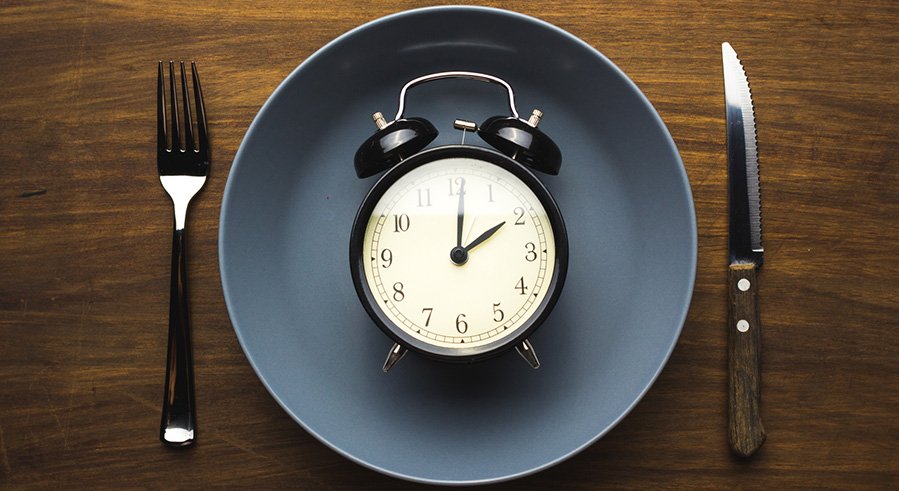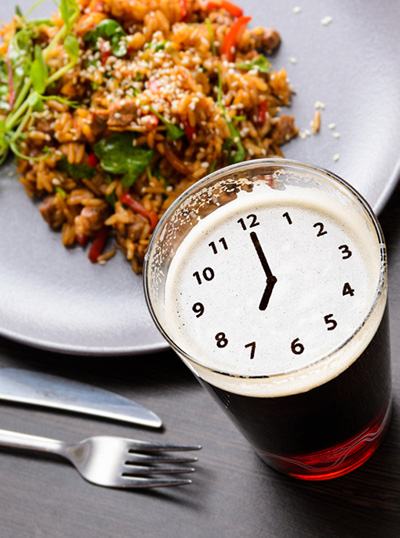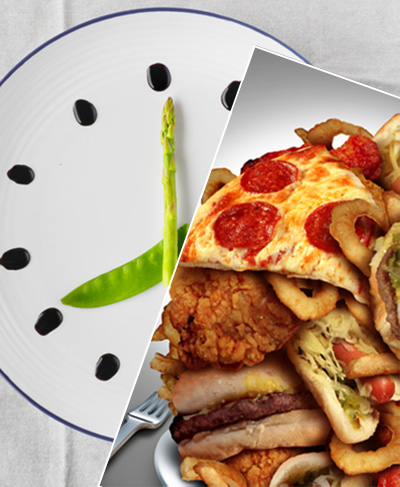Does Intermittent Fasting Work?
“I find that most of my clients who try the intermittent fasting protocol end up bingeing during their feeding window, and it turns into a disaster,” observes Kimberly Gomer, MS, RD, Director of Nutrition at the Pritikin Longevity Center.

What is intermittent fasting?
The two most common forms of intermittent fasting are alternate-day fasting and periodic fasting.
Alternate-day fasting means you fast one day, usually eating less than one-quarter the calories of your body’s baseline calorie needs. The next day, you “feast,” eating as much as you want.

Periodic fasting means that you fast only 1 or 2 days a week. The other 5 or 6 days, you can eat as much as you want.
What is time-restricted eating?
Time-restricted eating is when daily food intake is limited to a 12-hour window or less – often 8 to 10 hours. You can pick the hours you want to eat, say, 7 am to 7 pm, or 10 am to 10 pm.
For both intermittent fasting and time-restricted eating, there’s little or no discussion of what you eat, or how much. The focus is when you eat.
Fans of both strategies claim they’re good not only for losing excess weight but also as tools for diabetes prevention and overall good health.

Does intermittent fasting work? Does time-restricted eating?
Data (though little has been published so far) suggest possible benefits. One study followed 16 overweight men and women who were intermittently fasting for 10 weeks. They lost on average about 5% of their body weight.1
In another study, 8 obese individuals practiced time-restricting eating for four months, limiting their food intake to a 10- to 11-hour window each day. They shed on average 7 pounds.2
But in the most comprehensive review3 of all the published data on intermittent fasting and time restricted eating, an expert committee appointed by the American Heart Association was not impressed.
Of particular concern among the AHA reviewers was the lack of evidence on the long-term effectiveness of these strategies.
“There are no data that indicate whether the weight loss can be sustained long term,” summed up Dr. Marie-Pierre St-Onge of Columbia University, Dr. Penny Kris-Etherton of Pennsylvania State University, and fellow authors of this AHA Scientific Statement.
“Future work in this area,” they wrote, should aim to examine if any beneficial effects observed “still persist in longer time (more than 52 weeks) randomized, controlled trials.”
Intermittent fasting | No better than daily calorie restriction
One recently published study4 did follow people who had tried intermittent fasting for one year.
The results were less than thrilling.
In this trial, 100 obese but healthy adults were divided into one of three groups:
- Alternate-day fasting (25% of calorie needs on fast days, 125% of calorie needs on alternating “feast” days);
- Calorie restriction (75% of calorie needs every day); or
- Control group (no intervention)
At the end of one year, average weight loss was similar in the alternate-day fasting group and calorie restriction group, and neither netted exceptional results. Those in the intermittent fasting group lost 5% of their body weight. The calorie cutters shed 6%.
Moreover, the dropout rate was highest in the intermittent fasting group. And in this group, LDL “bad” cholesterol levels were significantly elevated compared to those in the calorie restriction group.
Concluded the researchers: “Alternate-day fasting did not produce superior adherence, weight loss, weight maintenance, or cardioprotection vs daily calorie restriction.”

“Little benefit”
“The best research to date suggests that intermittent fasting and time-restricted eating will have little benefit for weight loss and weight maintenance beyond simply those that accrue from a reduced calorie intake and lower body fat stores,” sums up Kimberly Gomer, MS, RD, Director of Nutrition at the Pritikin Longevity Center.
Bingeing
Not only is there likely little benefit to these time-based strategies, there may be major downsides.
Observes Gomer: “I find that most of my clients who try the intermittent fasting protocol end up bingeing during their feeding window, and it turns into a disaster. We should be driven by time-honored truths and good science, not passing fads.”
Longevity hot spots
Good science on the healthiest, longest living populations around the world – people, for example, living on the island of Okinawa in Japan, Sardinia in Italy, and Nicoya in Costa Rica – has found that none of these populations practices chronic, strict intermittent fasting.

What they do practice is daily eating focused on a largely plant-based diet rich in healthy, whole foods like fruits, vegetables, beans, and whole grains, with prudent amounts of lean meat and fish.
Calorie restriction, calorie counting, portion control
In addition to fads like intermittent fasting, another disappointment over the past several decades in America has been strategies like calorie restriction, calorie counting, and portion control.
“These strategies have overwhelmingly failed to aid long-term weight control and all too often can lead to bingeing and other eating disorders,” states Gomer. “They have forced millions to pit their will power against the very basic biological drive to eat when hungry.”
“Invariably, biological drives will win over will power,” teaches Gomer, in her classes at the Pritikin Longevity Center.
“If we try to lose weight by restricting calories and depriving ourselves of stomach-filling foods, we’re headed for trouble. Hunger kicks in, undermining our best intentions. Hunger almost always wins. When it doesn’t, people can starve to death; it’s called anorexia nervosa.”
What we eat, not when we eat
For losing weight and keeping it off, for optimal protection against chronic illnesses like heart disease and diabetes, and even, quite possibly, for prevention against age-related cognitive challenges like dementia, our focus should not be when we eat or how much we eat.
Our focus should be what we eat, teach the doctors, dietitians, and other faculty at the Pritikin Longevity Center.
Pritikin Eating Plan
“What we eat is the foundation of the Pritikin Eating Plan,” states Gomer. It is foods that provide the best way to lose weight without fighting chronic hunger. And it is foods proven in hundreds of studies to protect against epidemic cardiovascular-related conditions like heart disease, diabetes, and hypertension.
These foods, all part of the Pritikin Eating Plan, are:
- Low in calorie density
- High in nutrient density
- Whole (unprocessed or minimally processed)
4 Food Rules
There are 4 food-focused rules taught by Pritikin faculty. They naturally incorporate the benefits of reducing daily calorie intake but at the same time allow you to eat until you’re comfortably full.
“Chronic hunger is never a problem at Pritikin,” smiles Director of Nutrition Kimberly Gomer.
The foods recommended in these 4 rules also mirror the daily eating patterns of the healthiest and longest-living populations in the world.
Here are Pritikin’s 4 food rules:
1. Reduce the calorie density of the foods you eat.
Calorie density is the number of calories in a given volume of food. Certain foods have more calories packed into them – bite for bite, pound for pound – than others.
Cantaloupe, for example, has 140 calories per pound. Bagels have about 1,270 calories per pound. That means that with each bite of bagel, you’re taking in 9 times as many calories as each bite of cantaloupe. It’s pretty easy to see which one would pack on the pounds faster.
Foods low or moderately low in calorie density tend to be naturally rich in water and fiber. These foods, all part of the Pritikin Eating Plan, include:
- Fruits
- Vegetables
- Potatoes
- Sweet Potatoes
- Cooked Whole Grains, such as whole-wheat pasta, brown rice, quinoa, and oatmeal
- Legumes, such as peas, lentils, and beans like pinto, garbanzo, black beans, and red beans
- Plus, prudent amounts of nonfat dairy foods and lean animal foods, mostly fish
Foods high in calorie density – the foods we want to reduce for long-term weight-loss and good health – are generally two types of foods:
- Dry foods, such as cold cereals, dried fruits, breads, muffins, snack foods like pretzels and even so-called “healthy” snacks like veggie chips and dried green beans. They all pack a lot of calories into every bite you swallow. By the time you’re full, you’re also full of calories.
- Fatty foods, like oils, butter, margarine, cream, ice cream, cheeses, nuts, regular salad dressings, and fatty meat like ground beef.
Especially damaging, very often, are foods that are fatty and dry, like croissants, donuts, scones, pastries, chocolate bars, hamburgers, French fries, cookies, energy bars, granola cereals, cheesy breads, and potato chips. Yes, the majority of just about everything in “grab and go” places like gas stations and vending machines.
Because dry and/or fatty foods jam so many calories into each bite you take, “it’s easy – real easy – to go overboard on them before we begin to feel any sense of fullness,” notes dietitian Kimberly Gomer.
2. Eliminate most calories that come from beverages.
We do not compensate for the calories we drink by eating less food. Research5 has found, for example, that sugar in a solid form (jelly beans) provides more satiety for a given calorie level than when it’s dissolved in water (coke).
So try to avoid any beverage with calories, everything from soft drinks to “energy” drinks to frappuccinos to fruit juices.
Instead, increase your intake of foods rich in water, particularly:
- Fruits
- Vegetables
3. Increase your fiber-per-calorie ratio.
Studies6 have found that foods with more dietary fiber tend to make people feel satisfied longer than foods with less dietary fiber.
Foods rich in dietary fiber include: legumes (commonly called beans), such as pinto beans, black beans, and split peas; whole grains like barley and whole-wheat pasta; and many vegetables and fruits.
A number of studies7 have shown that, compared to low-fiber foods, high-fiber foods consumed at breakfast or lunch can significantly reduce food intake at the next meal.
High-fiber foods also tend to be foods that require a lot of chewing. “That’s a good thing,” notes Gomer. “The more you chew, the more satiety, or stomach-filling satisfaction, you get.”
4. Begin eating when mildly hungry and stop eating when comfortably full, but not stuffed.
A useful tool for Rule #4 is taught by the dietitians at the Pritikin Longevity Center. It’s called The Hunger Scale.
The Hunger Scale is important because nowadays many people are out of touch with their body’s hunger and satiety signals. Is it any wonder? Everywhere we go these days – every gas station, street corner, and office – we’re tempted with food, from 40-ounce sodas to cookies at our co-worker’s desk. We no longer ask ourselves, “Am I hungry?” “Am I full?” We just reach and nosh.
That’s why it’s so important to re-learn our hunger and satiety alerts. We say “re-learn” because we were born with these cues. Most babies and toddlers just naturally eat only when they’re hungry, and stop when they’re full (not stuffed).
To help you become re-acquainted with your body’s natural cues and give your weight-loss efforts the best chance for success, tack this Hunger Scale to your refrigerator. Keep another copy in your purse or pocket.
Your primary goals:
Begin eating at 3 (“Mildly Hungry”) and stop eating at 6 (“Comfortably Full”)
The Hunger Scale
-
Starving – Ravenous – Weak – Grouchy!
-
Uncomfortably Hungry
If you wait to eat till you’re starving (1) or uncomfortably hungry (2), you’ll likely be saying to yourself: “Where’s the nearest pizzeria?! I want the whole pie!” Yes, all hell’s broken loose. Any rational desires for healthy, low-calorie-dense foods have been overwhelmed by biologically propelled cravings for rich, calorie-packed fare.
-
Mildly Hungry
Begin eating when you’re mildly hungry (3). You want to feel some hunger pangs but still have control over what you will eat.
-
A Little Hungry
-
Not Full But Not That Hungry – “My mind is on things other than food.”
-
Comfortably Full
Stop eating at Comfortably Full (6). You know you could eat more, but if you did, you’d lose that nice feeling of lightness and likely end up bloated, your pants too tight.
-
Comfortable But Slightly Too Full
If you stop eating when you’re feeling comfortable but slightly too full (7), you’ll probably be feeling real full 20 minutes later. “And we all know that feeling,” smiles Kimberly. “In just minutes, we’ve gone from ‘I’m feeling fine’ to ‘I feel so big I need to loosen my belt.’”
-
Very Full – “I ate more than I needed.”
-
Too Full – Feeling Heavy and Uncomfortable
-
Thanksgiving Dinner Full – In A Food Coma!
Staying in The Hunger Scale range of 3 to 6 takes practice. The daily coaching at Pritikin is very helpful.
The results are well worth the effort. That’s because you’ll be enjoying not only a thinner body but a happier one. “When people are in tune with their hunger and satiety signals,” explains Kimberly, “they feel better, lighter, and they often have a lot more energy throughout the day.”
They aren’t falling into what Pritikin guests jokingly, knowingly, refer to as food comas, those “I-ate-so-much-I-need-a-2-hour-nap” feelings.
The fact is, food comas are no fun in the long run. For 5 minutes of stuffing pleasure, we often get 5 hours of feeling crummy and fatigued.
“Real pleasure is being able to spend our days feeling vibrant and alive, and that’s what paying attention to our hunger and satiety cues can help give us,” says Kimberly.
 At the Pritikin weight-loss resort, you can put any concerns about fasting, constant hunger, or binge eating behind you. The focus at Pritikin is sensible, scientifically validated principles for losing weight and improving health, not gimmicks.
At the Pritikin weight-loss resort, you can put any concerns about fasting, constant hunger, or binge eating behind you. The focus at Pritikin is sensible, scientifically validated principles for losing weight and improving health, not gimmicks.
Sources
- 1 American Journal of Clinical Nutrition, 2009; 90 (5): 1138.
- 2 Cell Metabolism, 2015; 22 (5): 789.
- 3 Circulation, 2017; 135: e96.
- 4 JAMA Internal Medicine, 2017; 177(7):930.
- 5 International Journal of Obesity, 2000; 24: 794.
- 6 Nutrition Reviews, 2001 59 (5):129.
- 7 European Journal of Clinical Nutrition, 1995; 49(10): 754.
- 8 Archives of Internal Medicine, 1991; 151: 1389.
- 9 Diabetes Care, 1994; 17: 1469.
- 10 Journal of Applied Physiology, 2005; 98: 3.
- 11 Archives of Internal Medicine, 1991; 151: 1389.